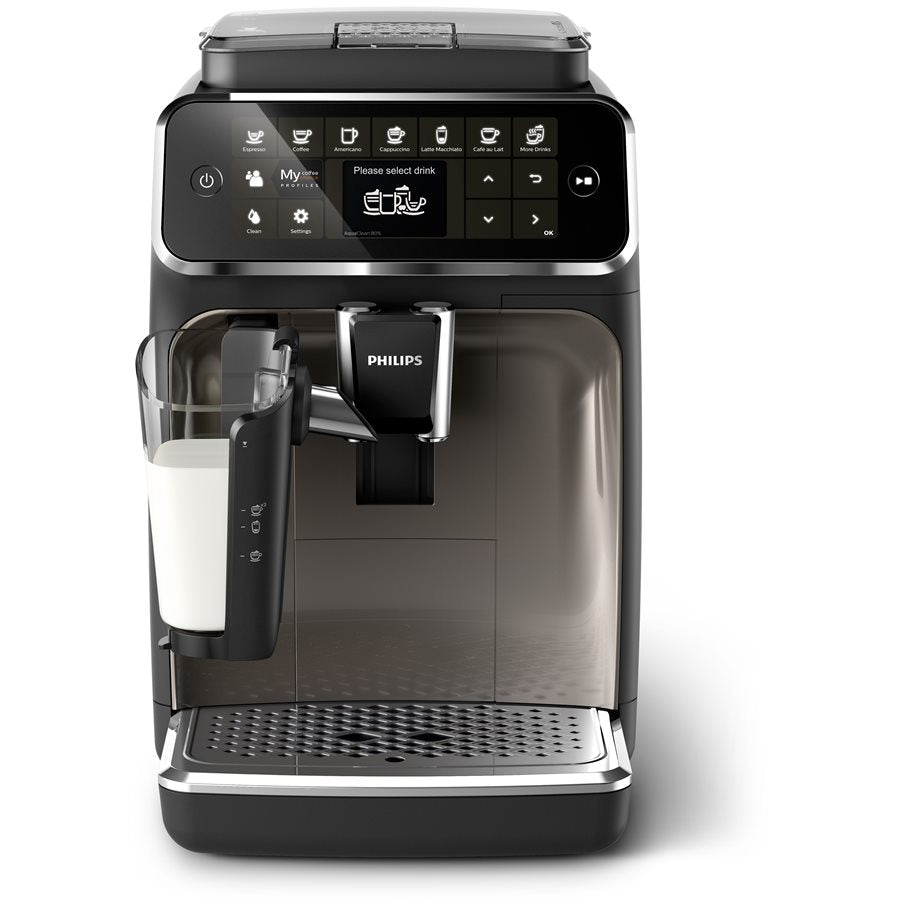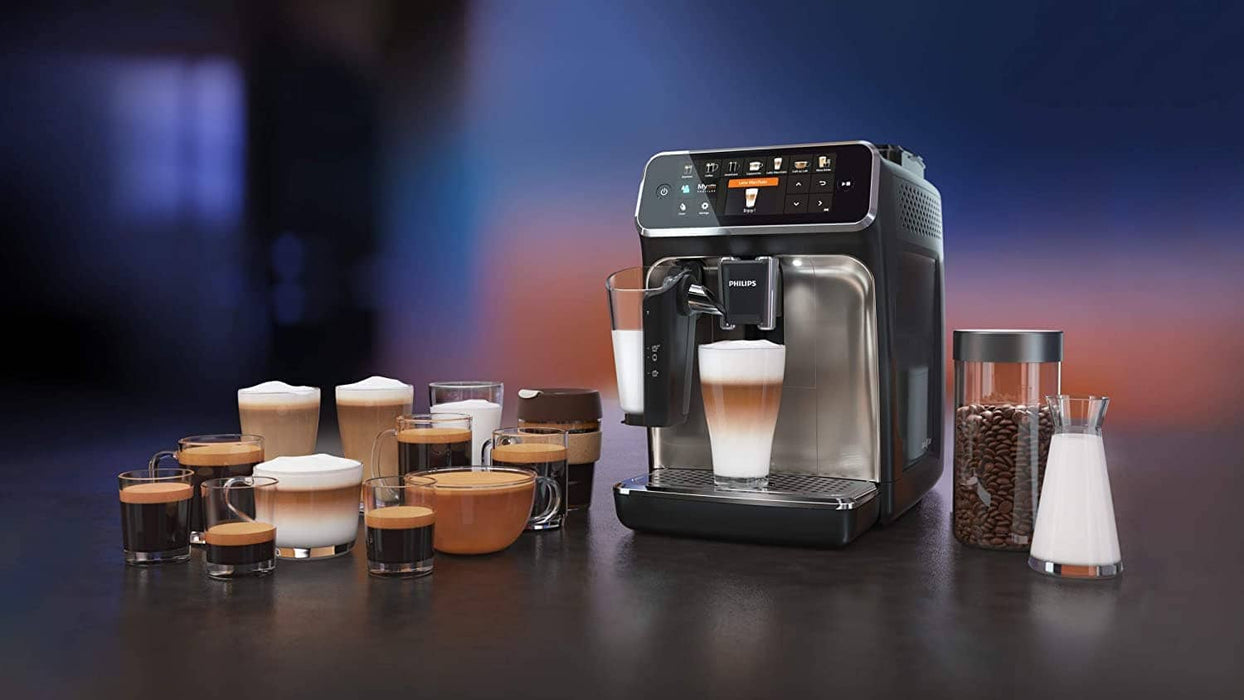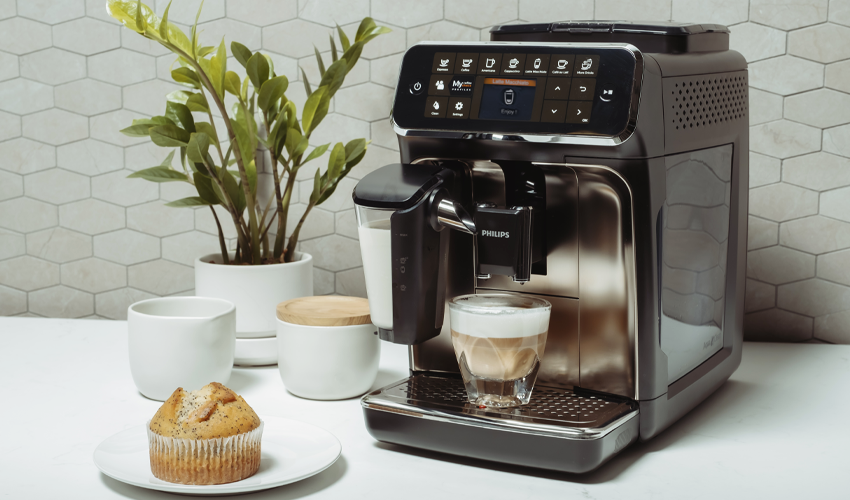#1: Philips LatteGo 5400

- Wide variety of drinks
- Advanced customization
- User profile options
#2: Philips LatteGo 4300

- Basic milk frother
- Small water tank
- Noisy grinder
As someone who enjoys a great cup of coffee every morning, I’ve always been on the lookout for machines that can deliver consistent quality, offer flexibility in coffee styles, and make the process as convenient as possible. After trying out both the Philips LatteGo 5400 and the Philips LatteGo 4300, I found myself leaning towards one over the other. Both machines are well-designed and capable, but my experience has led me to believe that the Philips LatteGo 5400 offers more of what I want in a coffee machine.
Let me take you through the details of these two machines, highlighting the differences based on my personal experience and why I think the Philips LatteGo 5400 stands out.

Why I Chose the Philips LatteGo 5400
Before diving into a direct comparison, let me share a bit about my personal coffee habits and what I value in an espresso machine. I like variety — whether it's an espresso in the morning, a creamy cappuccino in the afternoon, or a frothy latte after dinner, I want a machine that can handle it all. I also appreciate ease of use, as I don’t have the patience to deal with complicated systems or frequent maintenance. After using both the Philips LatteGo 5400 and the Philips LatteGo 4300, I found that the 5400 met all my needs and offered a little more than I was expecting.
The 5400 is designed with the home barista in mind, offering more versatility and advanced features that made it an easy choice for me after using both machines. It felt like a significant upgrade in both quality and convenience, and I didn’t mind paying a little more for that extra functionality.
Design and Build Quality: Philips LatteGo 5400 vs 4300
First impressions matter, and both the Philips LatteGo 5400 and the Philips LatteGo 4300 look sleek and modern on the counter. They share a similar aesthetic, with clean lines and a polished stainless steel finish. However, having used both machines for a few weeks, I found that the 5400 has a more refined build.
While the 4300 is certainly well-made, the 5400 feels sturdier in hand. The materials seem more premium, and the overall construction feels more durable. For example, the water tank in the 5400 is slightly larger, meaning I can go longer between refills — a subtle but important feature that I’ve come to appreciate. The 5400 also has a better-feeling grind setting dial and a smoother milk frothing system, which makes the experience feel a little more polished overall.
That said, if you're limited on space, the 4300 is a more compact option that still provides a solid coffee experience without taking up too much counter space. The size of the 5400 is a little bulkier, but for me, it was well worth it given the extra capacity and ease of use.

Coffee Quality and Consistency: Philips LatteGo 5400 vs 4300
When it comes to coffee, there’s nothing more important than getting the right balance of strength, flavor, and crema. After using both machines extensively, I can say that the Philips LatteGo 5400 is a clear winner in terms of coffee quality.
The 5400 features a more advanced grinder with multiple settings that allow for finer control over the grind size. This results in a more consistent and richer flavor profile in every cup. Whether I’m brewing a strong espresso or a smoother cappuccino, the 5400 is able to pull the perfect shot with a silky crema that stays intact for a longer period.
The Philips LatteGo 4300, while still producing good coffee, doesn’t quite match the depth and consistency that the 5400 offers. The espresso is flavorful but lacks that full-bodied richness that I find so satisfying in the 5400. It also doesn't have as much adjustability in terms of grind settings, which can be a limiting factor for someone like me who enjoys experimenting with different coffee strengths.
Milk Frothing System: Philips LatteGo 5400 vs 4300
Both the Philips LatteGo 5400 and the Philips LatteGo 4300 feature the LatteGo milk system, which is one of the standout innovations of these models. However, the 5400 takes it up a notch with a slightly more powerful milk frothing system.
What I love about the 5400 is how quickly it froths milk to a perfect, creamy texture. I’ve made plenty of lattes and cappuccinos with this machine, and I’ve been consistently impressed with the foam quality — thick, velvety, and stable. The 5400’s frothing technology also produces a finer microfoam, which makes a significant difference in the texture of the milk. It feels like I’m getting that professional barista quality at home.
In contrast, the Philips LatteGo 4300 also delivers decent milk frothing, but it’s a bit slower, and the foam isn’t as thick or long-lasting. While still a great option for anyone who loves a cappuccino or latte, it lacks that smooth, silky finish that I get from the 5400. If you drink a lot of milk-based coffees, the 5400 will certainly enhance your experience.

Customization Options: Philips LatteGo 5400 vs 4300
For someone who loves tailoring my coffee to my exact preferences, the Philips LatteGo 5400 offers just the right level of customization. The touchscreen interface is intuitive and easy to navigate, allowing me to adjust coffee strength, temperature, milk texture, and even brew time for the perfect cup. I can save personalized profiles for different users in my household, which means everyone gets their coffee just the way they like it.
The Philips LatteGo 4300, on the other hand, has a more basic interface with fewer customizable settings. While I can still adjust the coffee strength and milk froth level, it doesn’t offer the same level of fine-tuning as the 5400. For me, having the ability to really play around with the settings and save my preferences was a key factor in choosing the 5400. If you're someone who likes to have complete control over your coffee, the 5400 will give you that freedom.
Ease of Use and Maintenance: Philips LatteGo 5400 vs 4300
I can’t stress enough how important ease of use and maintenance are for a coffee machine. Both the Philips LatteGo 5400 and Philips LatteGo 4300 are relatively easy to clean, thanks to the LatteGo milk system, which can be rinsed quickly under running water. Both machines also have automatic cleaning functions that make maintenance a lot more manageable.
That said, the Philips LatteGo 5400 has a larger water tank and bean hopper, which means less frequent refills. The 5400 also has a more efficient self-cleaning feature, making it feel like it requires less effort to maintain over time. The 4300 is still very easy to maintain, but I found myself needing to empty the water tank and refill the bean hopper more often than I did with the 5400. For anyone who wants a hands-off experience with minimal maintenance, the 5400 is definitely more convenient.
Price and Value for Money: Philips LatteGo 5400 vs 4300
The Philips LatteGo 5400 does come at a higher price point compared to the 4300, but in my opinion, it’s worth the investment. If you’re someone who values customization, richer coffee quality, and faster, more stable milk frothing, the 5400 offers a more premium experience that justifies the higher cost.
The Philips LatteGo 4300, on the other hand, is more affordable and still delivers a good coffee experience. It’s a great choice if you want a reliable machine for basic coffee brewing without all the bells and whistles. If you don’t mind missing out on some advanced features and customization options, the 4300 provides solid value for money.
Final Thoughts: Philips LatteGo 5400 vs 4300
Having used both the Philips LatteGo 5400 and the Philips LatteGo 4300, I can confidently say that the 5400 provides a better overall experience, especially for someone who wants more control over the brewing process and enjoys a variety of coffee styles. The advanced milk frothing system, improved coffee quality, and extra customization options make it the better choice for anyone looking to elevate their coffee routine.
That said, if you're on a budget or don’t need all the extra features, the 4300 is still a fantastic machine that will get the job done. Both machines are reliable and well-built, but for those who want the best of what Philips has to offer, the 5400 stands out as the more versatile and high-performing option.
Frequently Asked Questions (FAQ)
Q: What is the difference in coffee quality between the Philips LatteGo 5400 and 4300?
A: The Philips LatteGo 5400 offers a more refined coffee experience with a better grinder and more customizable settings. The coffee is richer, with a fuller crema and more consistent results. The 4300 also produces good coffee, but the flavor depth and consistency aren't quite as strong as the 5400.
Q: Are the milk frothing systems on both machines the same?
A: Both machines feature the LatteGo milk system, but the 5400 has a more powerful and efficient frothing system. It produces creamier, thicker, and more stable foam faster. The 4300 delivers decent foam but lacks the same level of richness and consistency as the 5400.
Q: Which machine is easier to clean?
A: Both the Philips LatteGo 5400 and 4300 are easy to clean, with both having self-cleaning features and dishwasher-safe milk frothing systems. The 5400 has a slightly larger water tank, so it requires fewer refills. Overall, both machines are quite low-maintenance, but the 5400 offers a more convenient experience with less frequent cleaning required.
Q: Is the Philips LatteGo 5400 worth the higher price tag?
A: If you’re looking for a more customizable experience, better coffee quality, and faster, richer milk frothing, the 5400 justifies the higher price tag. It’s definitely worth the investment for those who want a more versatile and premium coffee machine. If you only need the basics, the 4300 is a great option at a more affordable price.
Q: Can I make multiple coffee styles with the Philips LatteGo 5400?
A: Yes! The 5400 offers a wide range of coffee styles, from espresso and lungo to cappuccinos and lattes. It also allows you to adjust coffee strength, temperature, and milk texture to match your personal preferences, giving you plenty of options to experiment with.
